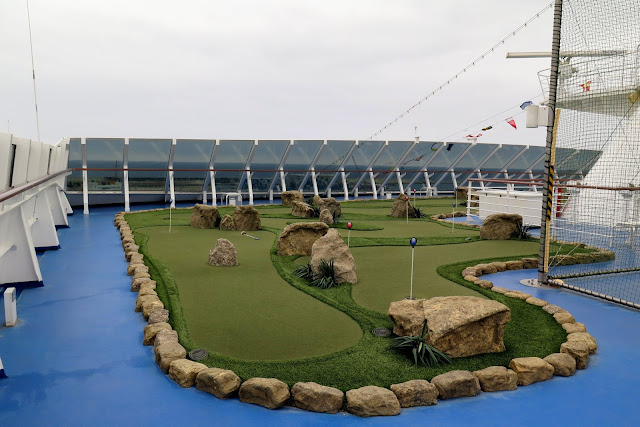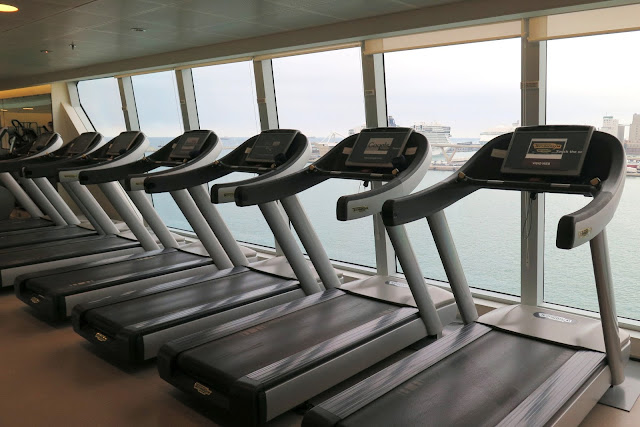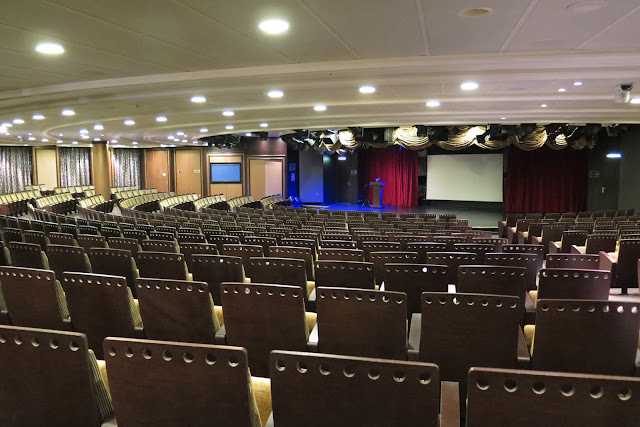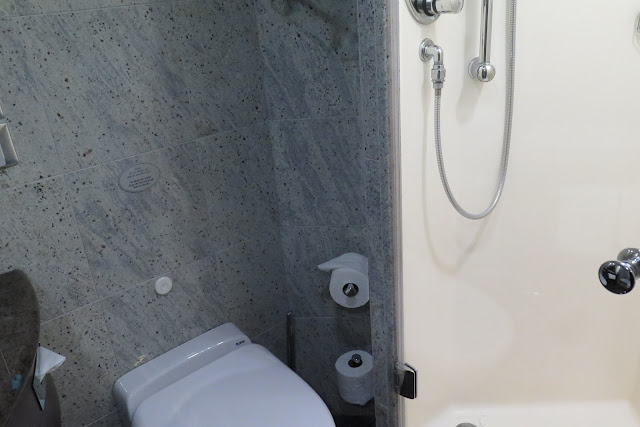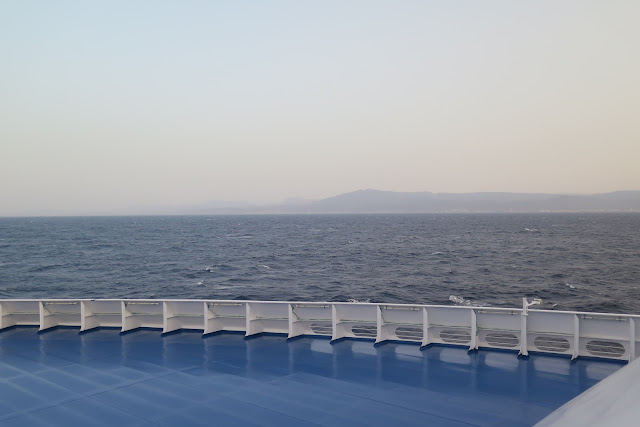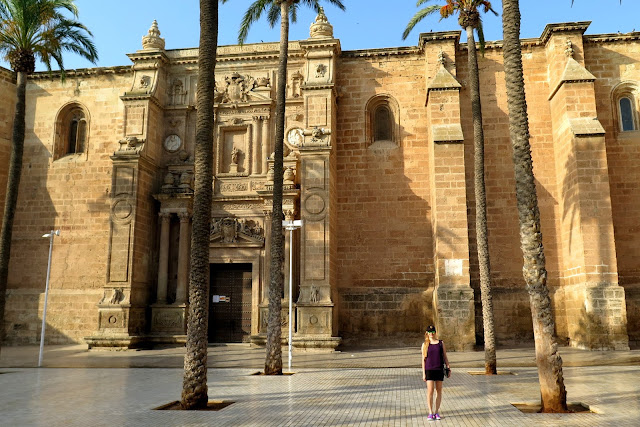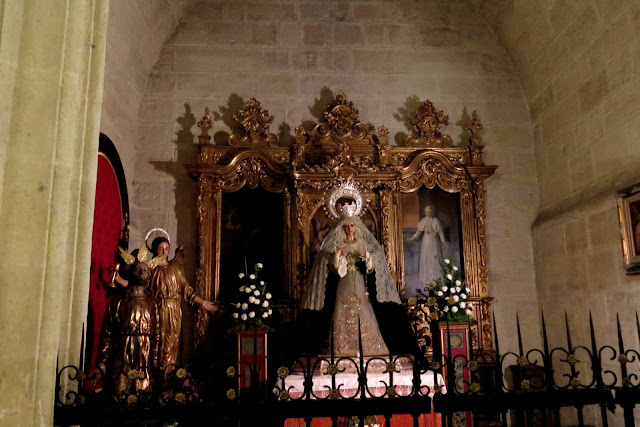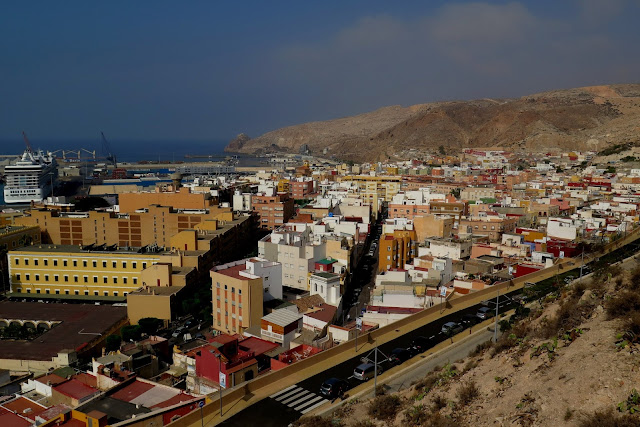Day 1
During the recent Raya hols we went for a trip to parts of the world we haven't been to before.
It was an amazing experience and we only wished we could spend more time there.
One of the countries involved we have to return and explore properly.
Amazing places .
As usual the grind of getting there .
A380 :-)
Our start point was Barcelona.
As we've toured it previously, today was just land ,eat and zzzzz
Day 2
Early the next morning its to the port .
Our ride for the next week +
Quite a busy port .
This is a big one .
A floating skyscraper.
My blonde Spanish girlfriend likes it :-P
As we make our way onboard...
We get to see the beautiful interior...
Nicer than most hotels.
...we realized that when we board ,and before.....
..everyone boards....
...that is the best time to tour the ship...
You have it all to yourselves .
Cloudy Barca..
A really nice place...
This is the life .
Today is the only day with clouds...
The rest of the trip was better .
Nooks and crannies everywhere .
And a fully equipped gym .
Spa...
And our favourite place...
As we walk from one end to the other...
Its still nice and quiet .
Almost at the front...
Right at the front...
Lots of activities for the guests...
Libraries and internet...
Now we check out SOME of the restaurants...
Opulent...
All of them are...
Passing the library to get to the other side...
And a small bar...
A cafe and grill....
Lots of lounges for couples.
The heart of the ship...for the guest.
An Italian restaurant.
As we continue the tour...
Yet another bar...
Happy senorita.
Then there is a huge auditorium .
Some very nice shows here .
Yet another restaurant...Asian food .
In our first cruise we had a regular cabin at the side. .
In our 2nd cruise we had a cabin at the rear of the ship .
This cabin is very nice .
Nicer than some hotels .
The all important sofa. Very very important.
A tub :-)
And separate shower .
For this cruise we got a cabin .
Here...
Above us...
Our cabin is right infront of the ship....woohoo
The most well travelled bunny in the world .
What a view :-)
Home :-)
Amazing especially at nights .
Soon its time to set sail.
Moving out...
My view for the whole cruise :-)
That ship looks familiar...
Ah.....
Time to sit back...
Have a drink...
Right at the rear of the ship.
This is the life .
My view for the whole previous cruise .
So a great first day...
As we watch the sun set over the Mediterranean sea .
Amazing .
Day 3
Early the next morning...
Time for brekkie...
Nothing beats this view .
Across the whole breadth of the ship .
Today we dock at Alicante ,Spain .
The best seat in the house .
Travelling by ship everything is organized and smooth .
No carrying of bags ,packing and unpacking .
Located in the heart of the Mediterranean, Alicante is a vibrant and popular Spanish resort town and during the years of Roman rule, was called Lucentum, the City of Light.
There are many excursions to choose from...
So we decided to head a bit out of town...
Along the coast .
Through the Spanish country side .
To the town of Guadalest .
Quaint small towns along the way .
And stunning scenery .
Till we finally reach .
Guadalest, the 'Eagle's Nest', is located about 25 km inland from Benidorm along the CV-70 road, just over 1 hour from Alicante. It enjoys one of the most spectacular locations of any village in Spain, set high up on a pinnacle and carved out of a mountain top in the midst of truly stunning scenery.
San Jose (Saint Joseph) Castle, Guadalest
Rock of Alcala, Guadalest .
Today only the lower half of the cylindrical castle tower may be seen. It could watch over the valley from this strategic point, and protected the north flank of Guadalest Castle.Because of its striking appearance it has become one of the best known images of Guadalest.
Little of the castle of San Jose (Saint Joseph) remains. It can be seen at the highest point of the cliff towering over the old walled town. The castle was very important due to its strategic situation. It was originally constructed in the 12th century, was reformed in the 15th and in 16th centuries, was practically leveled by an earthquake in 1644.
Senorita ...
And the Castle .
The small town below...
Now its time to walk .
An old cistern .
All the tours are guided .
We're just being lazy...
Narrow streets...
But very quaint .
Magnets :-)
Straight and up...
Nice huh :-)
More beautiful streets...
And then its up...
Past Spanish gardens...
And Spanish blondies...
Reminds me of Delphi in Greece .
History everywhere .
Long way up .
Bur the views get better as we walk...
Nice .
Rest of the tour group...
Here we are .
The castle entrance...
The castle can only be entered by one small tunnel cut through the rock at the San Jose gate. The area inside the walls includes the ancient city dungeon, the bell tower, Saint Josep castle, the Orduña House, parish church and the Moorish fortified building called Alcozaiba.
The inner part of the village...
Cobblestones...see :-P
We are first visiting Casa Orduna...
Built in 1644...
Some of the interior displays...
Detailed.
The interior is relatively untouched...
...from ages past.
Old skool guns .
Check out the toilet :-)
Colours everywhere .
And lots and lots of books .
Going up...
We see out next destination .
Alcozaiba fortress
The surrounding views .
A long walk up .
In the hot summer sun .
The Alcozaiba fortress is an 11th century fortress built by the Moors. It is located on the property of the Orduña House. Today all that is left is a restored tower.
Turquoise waters below .
Finally the top .
Ancient walls with a great view of the valley .
180" view .
The river Guadalest flows through the area and has been dammed to form a spectacular a reservoir below the town
Like so .
A small graveyard at the top of the hill .
Crypts and all .
The view does not get old though .
Surrounded by the Aitana, Serella & Xorta Mountains
Looking down on the small town .
We make our way down...
Till we reach the village in the center of the castle .
Small and quaint .
The houses the Moors lived in then were built outside the San Jose gate. This part of the town, "el Arrabal", with its little streets and squares is where the majority of the shops, craft shops, museums and restaurants are today.
After a bit of shopping...
...we head back to Alicante .
Past the town center .
And head back to the port .
Time to kick back...
Have some tea...
And just chill .
The joy of not having to lift a finger :-P
Every night there is a different show after dinner .
But for us ,this is the best show ever ,
Summer nights from my balcony . Amazing .
Day 3
A new day a new port .
Almeria ,Spain .
From the ship we board a coach.
Driving through downtown Almeria .
which lies in a region of Spain that has been inhabited since the Bronze Age. Highly coveted Almeria was repeatedly conquered by the likes of the Phoenicians, Romans and Moors until all the occupied lands were finally recovered under the rule of Ferdinand and Isabella in 1492.
Then we start the walking part of the tour .
Fortress like churches .
Narrow Spanish streets...
Till we reach here .
The Cathedral of the Incarnation of Almería .
Next stop .
Nice meditrennean trees .
Almeria's hefty cathedral is at the heart of the old part of the city and was begun in 1524 to replace a predecessor wrecked by the earthquake in 1522. The architecture is a combination of Gothic and Renaissance, its fortress like appearance was due to suffering raids by pirates from North Africa.
Is beeeeg
We are just checking out the outside here...
Snap a few shots...
Almeria Cathedral, much like the Alcazaba, symbolises the ages of conflict forced upon the population of the city.
Building commenced in 1524, not very many years after the city had settled under the reign of the new Catholic Monarchs, in the site of the previous building that was ruined by the 1522 earthquake.
It is unique in its appearance, its castle like towers held cannons and armoury, and its resemblance to a fortress had good reason. PIRATES.
Pirates and privateers operating from the North African capital ports of Morocco, Algeria, Tunisia and Libya, an area that became known in Europe as the Barbary coast, were initially attracted to the area because of the cargo of the merchant ships. However in the 16th century and onwards, in addition to seizing ships they would raid the city for another purpose, to capture Christian slaves to be sold into the Islamic market in North Africa and the Middle East, attacks which increased in frequency when these territories came under the sovereignty of the Ottoman Empire.
The Cathedral was not only a religious sanctuary, due to its close proximity to the port area, it also functioned as a defence fortification, protecting the people of the city in the times of these horrendous invasions.
Building commenced in 1524, not very many years after the city had settled under the reign of the new Catholic Monarchs, in the site of the previous building that was ruined by the 1522 earthquake.
It is unique in its appearance, its castle like towers held cannons and armoury, and its resemblance to a fortress had good reason. PIRATES.
Pirates and privateers operating from the North African capital ports of Morocco, Algeria, Tunisia and Libya, an area that became known in Europe as the Barbary coast, were initially attracted to the area because of the cargo of the merchant ships. However in the 16th century and onwards, in addition to seizing ships they would raid the city for another purpose, to capture Christian slaves to be sold into the Islamic market in North Africa and the Middle East, attacks which increased in frequency when these territories came under the sovereignty of the Ottoman Empire.
The Cathedral was not only a religious sanctuary, due to its close proximity to the port area, it also functioned as a defence fortification, protecting the people of the city in the times of these horrendous invasions.
Of the exterior...
...and surroundings... ;-P
Then its time to check out the interior...
Inner courtyard...
Huge doors...
Massive interior
And the ornate altar...
Those pipes look like rocket launchers .
Choir section .
Opulance everywhere .
After checking out the main section...
Now we go to the...
...side cloister .
And adjoining chapels .
A tomb in the cathedral...
The chapel behind the main altar contains the tomb of Bishop Villalan who was the founder of the cathedral
Back in the main part...
Past the huge organ...
Past the courtyard...
In to another section of the Fort/Cathedral .
For the nobles...
And many many treasures .
The church has always been rich .
In a place of pride...
Very very old books .
Don't ask :-)
A last look at this huge structure...
Then it out and uphill...
Hate walking .
Us :-)
Very Spanish decor .
Old streets and windows .
Our next destination is ahead .
Past this statue...
Who i'm guessing is the Moorish Caliph .
Till we reach here .
The Alcazaba of Almería is a fortified complex in Almería, southern Spain. The word alcazaba, from the Arabic word al-qasbah, signifies a walled-fortification in a city.
More walking :-(
The views of Almeria...
Not a big city
Approaching the main entrance .
With senorita :-)
The main entrance...
Opens up into a nice garden .
Holding a commanding position above the city centre, the Alcazaba castle is a must see monument and highly recommended historical attraction.
The word Alcazaba comes from the Arabic word for citadel, it describes a Moorish city and walled fortification. Offering shelter in times of battle, and not without its majestic palaces, it was designed to support and maintain the trade and livelihood of the population within the perimeter walls.
The Alcazaba of Almeria is strategically positioned on a hill, towering over the city and looking out towards the port and the Mediterranean sea. This colossal fortress, divided into three sections, is the second largest Moorish stronghold in Spain after the Alhambra in Granada. Its origins and turbulent history reflect of the unsettled ages of the city.
It was built in the 10th century under the reign of Abd-ar-Rahman, the most powerful prince of Iberia, in order to defend the prosperous city against enemy attack. These were ancient Moorish times when the Arabs were the rulers of Southern Spain. In the centuries that followed, Almeria city experienced many sieges, though it wasn't until the late 15th century that the city surrendered to the Catholic Monarchs, Ferdinand and Isabella, falling permanently into Christian hands. In the 16th century the city was subject to numerous earthquakes, of which the one in 1522 was particularly devastating and much of the city and parts of the Alcazaba were destroyed.
In recent years the Alcazaba has undergone a considerable amount of restoration.
The Alcazaba of Almeria is strategically positioned on a hill, towering over the city and looking out towards the port and the Mediterranean sea. This colossal fortress, divided into three sections, is the second largest Moorish stronghold in Spain after the Alhambra in Granada. Its origins and turbulent history reflect of the unsettled ages of the city.
It was built in the 10th century under the reign of Abd-ar-Rahman, the most powerful prince of Iberia, in order to defend the prosperous city against enemy attack. These were ancient Moorish times when the Arabs were the rulers of Southern Spain. In the centuries that followed, Almeria city experienced many sieges, though it wasn't until the late 15th century that the city surrendered to the Catholic Monarchs, Ferdinand and Isabella, falling permanently into Christian hands. In the 16th century the city was subject to numerous earthquakes, of which the one in 1522 was particularly devastating and much of the city and parts of the Alcazaba were destroyed.
In recent years the Alcazaba has undergone a considerable amount of restoration.
Of the three different fortified areas of the Alcazaba, the first section, encountered on arrival through the main entrance, is now principally a pretty garden area which incorporates the walk of the north wall and includes the ancient remains of the Arabic aljibes, the storage tanks that provided water for the citadel.
The garden area is truly beautiful, enhanced by the fortified historical surroundings, a world away from the hustle and bustle of the city streets below.
The garden area is truly beautiful, enhanced by the fortified historical surroundings, a world away from the hustle and bustle of the city streets below.
Looking over the walls .
Nice huh .
Murder holes.
This is a big fort...
With quite extensive gardens .
More walking , uphill...
Past fountains...
The gardens lead to the wall of the watchtowers, its centrally positioned bell was added to the fortress to warn the population of the impending pirate raids that were regular occurrences between the 16th and 18th centuries. This connecting wall separates the first and second sections of the monument and also links the north and south watchtowers. Entry to either watchtower can be achieved from the second enclosure. From both towers the panoramas are far reaching, the north tower offers views to the Cerro de San Cristobal, St. Christophers hill, and of the extended fortress walls that were built in the 11th century to enlarge the city defences.
Gravity fed streams and fountains.
The outer walls.
Access to the second enclosure and central section of the Alcazaba is gained by way of the wall of the watchtowers, via a characteristic Moorish room and archway leading onto a beautiful garden area with a pond and fountain. This section was home to the royal palaces, bath houses and mosque of the Alcazaba. After the Christain conquest the mosque was replaced by the Ermita de San Juan chapel, it was built by the Mudejar on order of the Catholic Kings. The Mudejar was the name given to individual Muslims that remained in the territory and submitted to the rule of the Christian Kings, it also denotes the style of Iberian architecture strongly influenced by Moorish workmanship which is still evident today throughout the entire city. The chapel is now utilised as a multi use exhibition room.
A nice aerial picture .
The inner gardens .
Very nice .
Centrally situated within the grounds, the Casas Arabes exposition, a reconstructed Arabic building, houses a display of ancient artefacts, dated from 10th century and onwards, and has a small room playing an informational video, in Spanish.
The palatial areas are mostly ruins, however placards are in place besides the palace foundations, they offer depictions of what the palace areas would have looked like and make the excavated remains easily identifiable.
The palatial areas are mostly ruins, however placards are in place besides the palace foundations, they offer depictions of what the palace areas would have looked like and make the excavated remains easily identifiable.
We're really high up now.
And we walk till the end .
The third part of the Alcazaba is the Christian castle, constructed after the conquest on instruction from the new sovereignty. The castle comprises of a courtyard and three towers, one of which, the tower La Polvora, the tower of gunpowder, has the defence cannons readily positioned for battle.
A clear view of the sea .
Its been a long day .
A closed off exit to the outer walls .
Spain is amazing .
A slow walk back...
But first we go to the top of the parapets .
Extensive outer walls .
A nice 180 degree view .
My ship there .
So Mediterranean
More pics...
A last look here .
Then a slow walk down .
Pretty senorita .
We head into the main part of town...
Where madam promptly goes shopping while i have a drink ,
And watch the people of Almeria .
Finally we head back to our floating home .
A late lunch...
As we sit back ...
Look at the Alcazaba .
And just relax.
Bliss.















